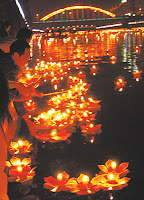There are many ghosts in Chinese culture; they have been worshipped by the Chinese for a few thousand years. Even Confucius said, "Respect ghosts and gods, but keep away from them."
While many people believe in ghosts, there are others who don't. The Chinese people often say, "If you believe it, there will be, but if you don't, there will not."
The ghost is a classical image in Chinese culture, one example is the young woman whose face is covered by long black hair, who dies due to misfortune, then comes back for revenge.
The word "ghost" for many Chinese conjures up similar images. Often the ghost is a beautiful young woman. The sudden switch from a beautiful girl to a frightening ghost is striking. The seemingly fragile, helpless and beautiful women turning into fearless killers are a favorite theme among Asian movie directors and storywriters.
Chinese Ghost Festival
Just as the West features Halloween for ghosts and ghouls, the Chinese have a holiday to honor the departed spirits of the underworld -- the Chinese Ghost Festival. It is said that ghosts roam the world every year for one lunar month. In some areas of China, visitors can see small roadside fires, where believers burn paper money and other offerings to appease the restless spirits that have temporarily been released from Hades.
Ghosts in Chinese culture
Nu Gui 女鬼
Female ghost often in long white dress and long hair. Woman who commits suicide in red dress returns as a ghost in red dress to take revenge on the living. Some ancient folk tales tell stories of beautiful female ghosts appearing like a woman, seducing lecherous men then killing them for their blood or for revenge.
Er Gui 饿鬼
A hungry ghost which has green or grey skin and a big belly, suffering from malnutrition and unsatiable hunger. It haunts the streets and kitchen, searching for food offerings and sometimes decomposed food.
Jiang Shi 僵尸
A Chinese vampire which feeds on the blood of living humans, chickens and even dogs. Often seen wearing Qing Dynasty official costume. Its corpse-body was so stiff that it had to hop to move around, while other stronger Chinese vampires were able to move around like a normal human. It could be immobilized by pasting a Taoist talisman on its forehead. Tales on Chinese vampires were most likely to begin during the late Qing dynasty and/or after the fall of Qing dynasty, where peasants often dress-up their deceased kins in Qing official costume as an honor to their ancestry. Female Jiang Shi were known to be dressed in Qing Princess/Concubine costumes. Pronounced as "Kyon Shee" in Cantonese.
You Hun Ye Gui 游魂野鬼
Wandering ghosts of the dead. Many of these roam the living world during the 7th month of Hungry Ghost Festival for a period of one month. Some which lost their way and were unable to return to the underworld continue to be a wandering spirit.
Wu Tou Gui 无头鬼-
Ghost of the beheaded. In ancient china, people who committed heavy crimes were sentenced to decapitation, and these headless ghosts roam the execution site.
Diao Si Gui 吊死鬼
Ghost of people who were hanged to death in an execution or suicide, often appearing as being hanged by a rope and with a long tongue.
Yuan Gui 冤鬼
Those who died unrightfully due to injustice or wrong accusations become such a ghost which cannot go to the underworld because of their depressed and restless spirit. Their helpless cries can be heard at night, sometimes looking for people to help them clear their names or resolve their problems in the living world.
Gui Po 鬼婆
Ghosts in the form of an old lady. They are particularly concerned with matters of young children or babies. While some can appear in hideous appearance and hostile, some others look friendly and helps people who are in trouble.
Gui Shu 鬼树
Which means "ghost tree". These are haunted trees which do not move but can confuse the paths of travellers by appearing in random locations, causing them to lose their way in the forests. The spirits that dwell in them do not appear to people but the mere appearance of the tree itself gives a spooky shiver to those who look at them at night.
Shui Gui 水鬼
Ghost of the drowned or "water ghost". It seeks to drown a person by pulling his/her leg and drag the victim into the water deep, so as to take over his/her place in the living world and return as a newborn. These ghosts dwell in rivers, lakes or seas and stay wherever they formerly drowned.
Hei Bai Wu Chang 黑白无常
Also known as Da Ye Bo and Er Ye Bo 大爷伯 二爷伯 which means "great grand-elder" and "second grand-elder". These two were guards of the Chinese hell whose tasks were to bring the souls of the dead to hell for sentencing by the King of the Hell, Yan Luo Wang 阎罗王. They had tall hat and long dress which covers the limbs, sometimes carrying a seal on the right hand and a stick with cloth pieces on the left hand. The elder one wears in white while the second one wears in black. Both have very long tongues.
Niu Tou Ma Mian 牛头马面
These two guards of the underworld have about the same role as the above Hei Bai Wu Chang, but they had head of a horse and a cow, carrying pitch-fork and chains in their hand to chain up spirits or ghosts. Their names mean "cow head" and "horse face".






















